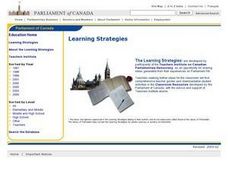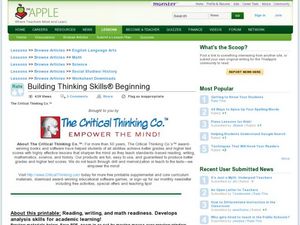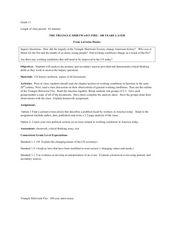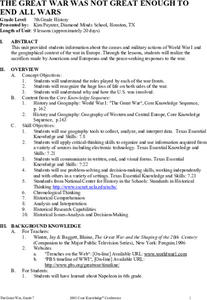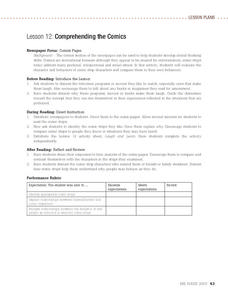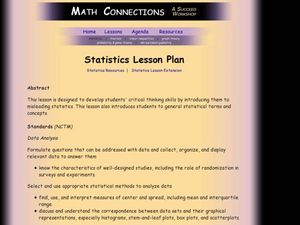Curated OER
Ancient Roman Monuments and Timeline
While a terrific idea, this lesson in which learners create a timeline showing the date that a variety of buildings and monuments were built in Ancient Rome, requires resources teachers may not have. It requires the use of a Smartboard,...
Curated OER
It's All Greek to Me!
While the ideas for Ancient Greek research are solid, there is little detail to help make your job easier. The focus here is familiarizing your class with online databases and print resources in their school library. After direct...
Curated OER
Joseph Holston Exhibition Lesson Plan
Students, in groups, view original artworks by Joseph Holston in a gallery space. They create a genre work of art that emphasizes the use of the artistic elements line, color, and shape.
Curated OER
Cloudy Days Are for Reading and Writing
Students consider a variety of well-known proverbs that refer to the weather. They research the scientific validity of these proverbs, conduct interviews about public perception of the proverbs and summarize their findings in writing.
Curated OER
Antisense Oligonucleotide Therapy
Students conduct Internet research on Antisense Oligonucleotide Therapy. They design a puzzle to represent these processes, read and summarize an article, conduct research, and design a theoretical experimental procedure.
Curated OER
It's Debatable!
Students examine the basic elements and vocabulary of debating. They research an issue and write a letter to the editor of the local newspaper, and role-play a Parliamentary debate on a particular bill.
Curated OER
Cranes, Crosswalks, and Big Gulps
Students watch a video and answer questions based on wildlife jobs. In this wildlife lesson plan, students learn that biologists don't just play with animals but that there is a lot of study involved.
Curated OER
Thinking Skills: Connecting shapes
In this thinking skills worksheet, students draw a line connecting each blue figure without touching any other color. Students connect 4 figures.
Curated OER
Causes of the American Revolution
Students access websites for background information and learn how to interpret political cartoons. They incorporate higher-order thinking skills to determine if the information presented in the cartoons is accurate, what the colonists...
Curated OER
Putting Your Best Foot Forward
Third graders measure their feet and their parents' feet, record data on computer-generated graphs, and calculate and record mean, median, and mode.
Curated OER
Eudora Welty's "A Worn Path" in Graphical Representation
Learners analyze graphical forms of Eudora Welty and interpret the shorts stories in the representations. In this graphical representations lesson, students analyze the short story genre in comic strips. Learners then create their own...
Curated OER
The Triangle Shirtwaist Fire: 100 Years Later
Eleventh graders examine the impact of the Triangle Shirtwaist Fire. In this American History lesson, 11th graders analyze various sources. Students create a cartoon representing the impact of this fire on the United States today.
Curated OER
The Great War Was Not Great Enough To End All Wars
Students examine the causes and military actions of World War I. In this World History lesson, students study the sacrifices made by Americans and Europeans. Students read and analyze primary sources related to World War I.
Curated OER
Lord of the Flies - Sentence Starters and Vocabulary
Learners prepare for the reading of iam Golding's novel, The Lord of the Flies, by exploring the theme through a discussion and sentence starter activity.
Curated OER
Getting Around - Transportation Photographs
Students locate historical photographs of different types of transportation on a given website. They choose three to analyze and write about. If there is no information with the photo, students will need to research their chosen types of...
Curated OER
Natural Disaster Risk at Home
Students analyze the natural disater threat and potential mitigation techniques of their (parents?) home. They apply classroom knowledge to students, non-academic daily life. Students recongize how earth processes specifically affect...
Curated OER
Constructivist Theory
Students in a teacher education program are introduced to the constructivist theory. In grade level teams, they take their subject matter focus and create lesson plans related to the constructivist theory. They are graded with a rubric...
Curated OER
Comprehending the Comics
Students discuss and examine the comic strip section in newspapers. They compare and contrast themselves and others with the comic strip characters. With partners, they select a comic strip and complete a student activity sheet.
Curated OER
Twain: Icon and Iconoclast
Students examine work by Mark Twain in the context of pre- and post-Civil War America. For this cross curricular lesson, students gather biographical information about Twain, use a Venn diagram to compare and contrast him with Lincoln...
Curated OER
Optical Illusions
Students investigate optical illusions. In this optical illusions lesson plan, students explore perception. Students analyze optical illusions and determine common misconceptions.
Curated OER
Pooling Around
Students complete a unit of lessons on computing area and volume. They play a Jeopardy game of basic area formulas, calculate surface area of shapes, develop a Powerpoint presentation, and conduct a simulation of finding the surface area...
Curated OER
Statistics: Misleading or Accurate?
Students explore the concept of misleading statistics. In this misleading statistics lesson, students play a game of tag and graph the number of times each student gets tagged. Students use the graph to determine the fastest runner in...
Curated OER
Jelly Belly: What a Wonderful "Bean"!
Students explore how jelly beans are produced. They discuss the origins of the jelly bean and view a video about how jelly beans are prepared, tested, shaped, finished, and shipped and estimate the amount of jelly beans in a jar and sort...
Curated OER
Hurricane Tracking
Students access the Internet to find information on current hurricanes. They get locations, speeds, and air pressures and then plot the location of the hurricane on a hurricane-tracking map. They also access the FEMA website to solve...







